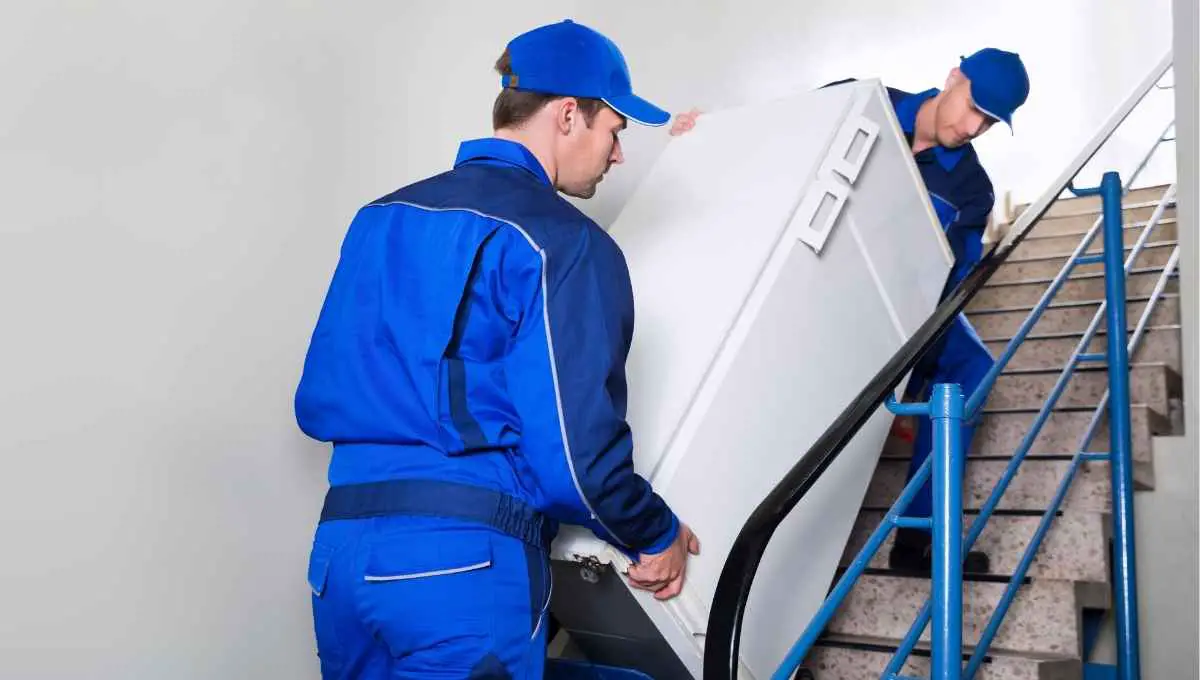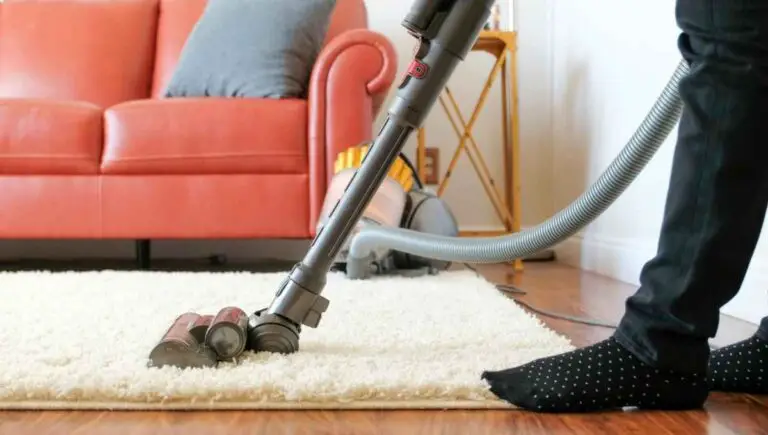Can You Put a Refrigerator on Its Side? (What Might Happen)

Transporting a refrigerator can be a hassle, especially when you have limited transporting space. You might consider putting the fridge on its side, and although this can be done, there are some things that you should consider.
You should avoid placing a refrigerator on its side, as this can damage the fridge over time. Refrigerators placed on their sides will often leak oil from its compressor. This oil can damage other internal parts of the fridge and require you to replace the compressor as well.
Most manufacturers don’t recommend laying a refrigerator on its side unless it is the only option for a short period of time. This article will discuss how to transport your fridge and what should be done after transport.
This post contains affiliate links. This means Household Blogger may earn a commission should you make a purchase using any of our links. Please refer to our full affiliate disclosure policy for full details.
Here’s a Quick Pro Tip!
You can put a refrigerator on its side if it is completely necessary, although many manufacturers advise against it. You run a higher risk of damaging your fridge when it’s on its side than when it is upright.
Our favorite products from Amazon to make moving a fridge easier:
1. Heavy-duty folding dolly – The best tool to use when transporting a fridge.
2. Simple dolly – Can be kept permanently under a fridge to make moving it around easier.
3. Shoulder dolly straps – An alternative method to keep a fridge upright.
Transport
It’s not every day that you would need to transport a refrigerator, but when you do need to, you might wonder if you can transport it on its side.
Let’s discuss why it’s not always a good idea to transport a fridge on its side.
Is It Okay to Transport a Refrigerator Laying Down?
It’s common to transport a refrigerator lying on its side, although it’s not recommended to lay it on its back. The sheer weight of the body could damage crucial parts in the fridge when lying on its back.
When transporting a refrigerator, you should wait a couple of hours before plugging the appliance into an outlet.
If it was transported on its side, you should wait 24 hours before plugging it in.
What Happens if You Transport a Fridge on Its Side?
Transporting your fridge on its side could cause the compressor oil to leak into the coolant lines. It’s always recommended to lay your fridge with the compressor facing up – to ensure it does not leak.
Some manufacturers do not recommend transporting certain models on their side at all.
You should always double-check with the manufacturer or in your user manual and reference the recommended transport directions.
Why Can’t You Transport a Fridge Lying Down?
A refrigerator is a heavy appliance, so if it’s transported lying down, all the weight falls onto the internal components of the fridge. The inner components are not designed to bear the weight of the refrigerator.
If transporting the fridge upright is impossible, it can be transported lying on its side.
It’s never recommended to transport a fridge on its back due to the sheer weight of the fridge on its own internal parts.
You might also enjoy our post on If You Can Put a Refrigerator on Carpet
How Long Can You Transport a Refrigerator on Its Side?
Transporting a refrigerator on its side for more than 24 hours is not recommended. Generally, the less time the fridge is on its side, the better since the internal parts of the appliance are not designed to absorb the weight of the appliance.
The rule of thumb is – after transporting a fridge, you should leave it upright and unplugged for the same amount of hours as the transportation took.
This gradually reduces the stress and strain on the internal components of the fridge.
How Do You Transport a New Refrigerator?
The most popular and safest way to transport a fridge is with a furniture dolly. These tools usually have a flat surface with four (or six) wheels mounted on the bottom. It’s designed to reduce the weight of the furniture greatly.
After using some manpower to lift the fridge onto the dolly platform, it’s relatively easy to move around.
This also makes it easier to transport your refrigerator upright, which is much better for the appliance.
How Do You Transport a Refrigerator in a Pickup Truck?
To transport a refrigerator in a pickup truck, you would need a furniture dolly and at least one person to assist you. It’s always best to transport a fridge upright on a pickup to avoid any coolant leaking.
You can use the dolly to lift the fridge onto the pickup and push it against the cab window.
Secure the fridge with blankets and rope to the truck; you would not want to damage the fridge or your pickup truck.
Laying On Its Side
Even though it’s not always recommended, sometimes you might have no choice but to lay a fridge on its side.
This section will look at what you should do while and after transporting a fridge.
Can You Lay a Refrigerator on Its Side for 30 Minutes?
It’s never recommended to lay a refrigerator on its side since the compressor oil and refrigerating coolant could leak. However, when it is necessary, 30 minutes would probably not cause irreparable damage.
For short transporting distances or quick maintenance, it can be acceptable to lay a refrigerator on its side.
Some manufacturers do not recommend laying this appliance on its side at all, so check your user manual.
Which Side Do You Lay a Fridge On?
It’s not recommended to lay your fridge on the side, but when necessary, lay it with the compressor facing upwards. This will prevent compressor oil from leaking onto the other parts of your fridge.
If the compressor oil or refrigerant coolant leaks onto other internal parts of the fridge, it could be damaged beyond repair, and manufacturers would not replace your fridge.
Always read your user manual for specific instructions for your model.
How Long Can a Refrigerator Lay On Its Side?
Some manufacturers recommend only laying a refrigerator on its side for a few minutes. Ideally, a refrigerator should not lay on its side at all. However, when necessary, for as little time as possible.
The general guideline is that if you transport or lay a refrigerator on its side, you should leave it upright for the same amount of time before turning it on again.
So if the fridge is on its side for one hour, you should leave it upright for one hour before turning it on.
How Can I Lay a Fridge Freezer Down to Transport It?
You can lay a fridge freezer on its side to transport, never on its back. The internal parts of the fridge are not manufactured to handle the weight of the fridge since it’s designed to stand upright.
When laying a fridge on its side, you should position blankets around it to absorb any shock.
Transporting a fridge upright is generally recommended since, in most cases, the appliance will take up less space and have a less likely chance of being damaged when upright.
Why Can’t You Lay a Refrigerator Down?
Laying a refrigerator down can damage all the internal parts, like the compressor. The oil inside the compressor is kept in place by gravity, although when the fridge is laid on its side, the oil can leak.
Refrigerant coolant and other liquids in the fridge could also potentially leak.
The internal parts of the fridge can be damaged under the strain of the weight of the fridge, so it’s always advised to keep a fridge in the upright position.
You might also enjoy our post on If You Can Move a Bathtub
Repercussions and Fixes
In this section, we’ll look at what could happen if you lay a fridge on its side. Luckily, you would probably be able to fix any damage by installing replacement parts – although it might cost you a pretty penny.
How Do You Fix a Refrigerator That Was Laying On Its Side?
Leave the refrigerator upright for a couple of hours and plug it in to check if it’s working. If not, you would need to take it to a technician, who can examine the fridge and detect any problems.
When a refrigerator lays on its side for a period of time, the compressor oil (and other liquids) could leak and settle in parts of the fridge where it would, causing damage.
The weight of the fridge adds a lot of stress to the internal parts and can also cause damage.
How Long Do You Wait to Plug in a Fridge After Moving It?
It’s generally advised that a fridge should stand upright and unplugged for the same amount of time as it was transported. So if a fridge was transported on its side for 5 hours, it should stand unplugged for 5 hours.
This is only a general guideline as some manufacturers never advise placing a fridge on its side. Specific models like the french door or bottom-freezer models should always be transported upright.
Why Do You Have to Wait 24 Hours to Plug in a Fridge?
Waiting 24 hours before plugging in a fridge allows the compressor oil to settle. If this oil is not properly settled, it could block and damage vital internal parts of your fridge – ultimately breaking the whole appliance.
Compressor oil lubricates and cools a fridge’s internal parts, which reduces the wear and tear of these parts.
Without compressor oil, your fridge will probably break down faster than you expected.
Do Modern Refrigerators Need to Settle?
Modern refrigerators do still need to settle after being transported, even when transported in the upright position. This is because the internal liquids of the fridge could leak in transport, and it needs the proper amount of time to settle.
Transporting a fridge in the upright position on a dolly allows you to cut down the amount of time it needs to settle.
Most manufacturers would recommend 1 – 2 hours if transported upright and 24 hours if transported on its side.
What Happens if You Turn a Fridge on Too Soon?
You might notice a sudden problem, but gradually you might notice your fridge slowing down and not working as well as before. This would mean that your compressor has broken, and it would cost a lot of money to install a new compressor.
The broken compressor will probably also cause inconsistent temperatures since the compressor is not cooling down certain fridge parts.
You would be able to notice this when food becomes spoiled sooner than expected.
How Long Should a Fridge Sit After Moving?
If a fridge was transported upright, it is recommended to let it sit for two to five hours. If a fridge was transported on its side, it’s recommended to let it sit for the same amount of hours that it was transported.
So if a fridge was transported on its side for 10 hours, it should be left upright and unplugged for at least 10 hours.
Some manufacturers recommend always waiting 24 hours, no matter the transportation method.
You might also enjoy our post on How Much it Costs to Move a Toilet
Related Questions
How Long Can a Refrigerator Lay On Its Back?
It’s never recommended to lay a refrigerator on its back simply due to the possible damage it could cause to the shelves and other internal parts. You can lay a fridge on its side for a few hours, although this is also not ideal.
By the manufacturers’ preference, a refrigerator should always be transported in an upright position.
If that is not possible, it can be transported to the side where the compressor faces up – thus not leaking onto other parts in the fridge.
Is It Okay to Lay a Freezer on Its Side?
Unlike a refrigerator, most manufacturers never recommend laying the freezer on its side. The internal compressor will leak, and this can cause damage to your freezer. It’s best to transport a freezer in its upright position.
After transporting a freezer upright, you should allow it to settle for a few hours before plugging it in.
This gives the compressor oil time o settle where appropriate and reduces the risk of internal damage.
Can You Lay a Mini Fridge on Its Side?
You should not lay a mini fridge on its side since this could allow drain water to flow back into the fridge. If you need to transport a mini-fridge on its side, you should turn it off 24 hours before allowing all the water to drain before transport.
After transporting a mini fridge, leave it upright and let the oil settle. Luckily you only need to let it stand for about one hour.
Since a mini fridge is much smaller than a regular refrigerator, the oil settles much more quicker.
Final Thoughts
In short, you should not put your refrigerator on its side as this could cause internal parts of the appliance to.
It’s recommended to transport a fridge in the upright position and allow it to settle for a few hours before plugging it in again.








